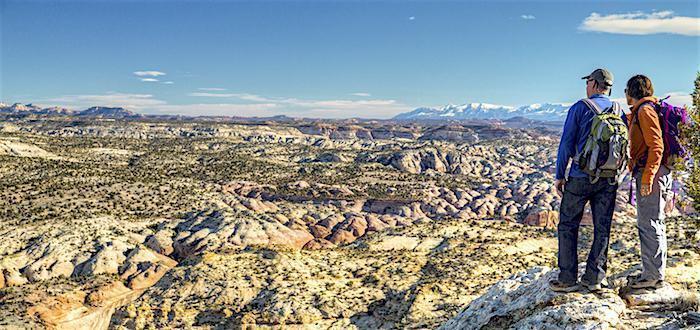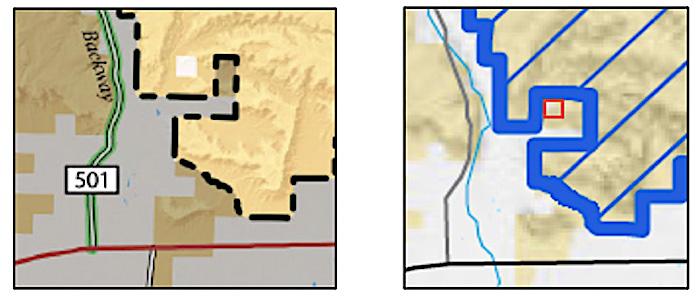
A group has asked for a federal investigation into how redrawn boundaries of Grand Staircase-Escalante National Monument have financially benefited a Utah legislator/BLM
In a state, Utah, where most politicians would like to take over federal lands, and where President Trump's proclamation breaking up Bears Ears and Grand Staircase-Escalante national monuments was rousingly applauded, there's a move to designate a "Donald J. Trump National Parks Highway."
The proposal, introduced to the Utah Legislature by a lawmaker who long has shown his disdain for federal lands management in the state, would attach that designation to a route that runs down U.S. 191 from Interstate 70, past Moab, and down to Blanding, where it would turn right to pick up Utah 95 West and head to Hanksville, where it would connect with Utah 24 and then Utah 12 towards Bryce Canyon National Park. The route would continue west to Cedar City and Interstate 15, where it would head south to St. George, head a bit north to run by Zion National Park, and then wrap up on U.S. 89 at Lake Powell inside Glen Canyon National Recreation Area.
All told, the proposed route would pass Arches and Canyonlands national parks, Natural Bridges National Monument, Capitol Reef and Bryce Canyon national parks, Cedar Breaks National Monument, and Zion National Park. And, of course, the fragments of Bears Ears and Grand Staircase national monuments.
"Contrary to some beliefs out there, Donald Trump really is a supporter of public lands. He’s a big supporter of national parks," state Rep. Mike Noel said in a Salt Lake Tribune story.
Nearly 3 million people across the country who voiced their opinions that the president should not break up Grand Staircase-Escalante and Bears Ears likely would disagree with Mr. Noel. However, for him the president's action placed a 40-acre farm he owns outside the new boundaries of Grand Staircase. The boundaries proposed by the administration take an interesting jog around his farm, according to maps obtained by the Western Values Project.

Existing GSENM boundary with Noel’s undisclosed land in white (Bureau of Land Management). Right: New GSENM boundary drawn to exclude Noel’s land from the monument. A red square (added) indicates Noel’s property. (Department of the Interior)/Western Values Project
Western Values, an organization that has battled the Trump administration and Interior Secretary Ryan Zinke for their public lands management decisions, earlier this week asked Interior's Inspector General to investigate how Mr. Noel benefited from the president's proclamation.
According to the group, the redrawn boundaries of Grand Staircase-Escalante also open up federal lands for a water pipeline from Lake Powell to St. George that would benefit the Kane County Water Conservancy District, which Mr. Noel heads as executive director.
"Representative Noel has gloated about his influence over the illegal redrawing of the Grand Staircase-Escalante boundary ever since Secretary Zinke first announced that it was on the chopping block - meeting with the Secretary multiple times,” said Chris Saeger, executive director of the Western Values Project. “What has become clear is that Noel failed to disclose the land he owned within the boundary to just about everyone, except maybe the Internal Revenue Service. Not only is Noel in violation of Utah state law but, more importantly, it calls into question how the proclaimed new Grand Staircase boundary came to be.”
U.S. Rep. Raul Grijalva also pressed Secretary Zinke on the seeming benefits Mr. Noel received from the boundary changes. He has asked the secretary whether he knew of Mr. Noel's land ownership in the monument; whether Mr. Noel told Secretary Zinke of his lands in the monument; whether he or his staff asked Mr. Noel if he had any conflicts of interest; whether he knows if any other elected official in Utah has a financial interest in the boundary changes for Grand Staircase-Escalante; and "how will the Department of Interior ensure that future administration policies are not tainted by similar financial conflicts of interest."
For his part, Mr. Noel told the Salt Lake Tribune that the monument boundaries created by Presidents Clinton (Grand Staircase-Escalante) and Obama (Bears Ears), prevented Kane County residents from grazing cattle in those areas, cutting firewood, and even attracting movie productions in search of Western landscapes.
At the Center for American Progress, Public Lands Director Kate Kelly shook her head at the proposal.
"The same anti-public lands representative who stands to financially benefit from Trump’s evisceration of national monuments now wants to stamp Trump’s name on a highway that honors national parks," she said in an email. "It is an absurdity, wrapped in a joke, inside an enigma. If this up-is-down proposal were to ever become reality, I can only imagine the amount of money Utah would have to spend to replace all the stolen and damaged signs; there’s a lot of creative ways to vandalize something with 'Donald J. Trump' and 'national parks' in the same sentence."
In its request for an investigation by the Inspector General, Western Values said:
"... it appears President Trump amended the boundaries of a national monument – in part and perhaps unknowingly – to financially benefit one person: Rep. Noel. As a result, the Office of the Inspector General should investigate this matter to determine: 1) the extent of Rep. Noel’s influence on the proposal to revise the boundaries of GSENM, including whether and to what extent the boundaries included in the proposal submitted to the president reflected changes suggested by Rep. Noel; 2) whether and to what extent Sec. Zinke was aware of Rep. Noel’s financial interest in revised boundaries43; 3) whether Sec. Zinke improperly granted Rep. Noel any preferential treatment in allowing him to influence the process and in the resulting proposed boundaries; and 4) whether, by allowing an individual with a financial stake in the outcome of the revision process, Secretary Zinke improperly created at least the appearance of a conflict of interest."
In his letter, Mr. Saeger stressed that, "general ethical precepts make clear that government officials may not make decisions for the improper purpose of bestowing preferential treatment or a financial benefit on any private individual. Yet this appears to be exactly what has taken place here."
On Monday, the Utah Legislation is expected to take up Mr. Noel's proposal to honor the president with a highway in his name.



Comments
It happens all the time and nobody is forced to sell. Someone mentioned it's called an "inholding" although some call them enclaves. The federal governement must also allow private inholders the right to access their inholdings without requiring any fees. There are quite a few in the west, including Wilsonia in Kings Canyon NP, as well as Foresta and Wawona in Yosemite. The operations that Xanterra has within Death Valley (including lodging, stores, restaurants, and a gas station) are private inholdings and thus not subject to NPS regulations. They also typically get access to utilities. However, redrawing the boundaries to specifically benefit one person would seem a little bit contrived.
Nothing all that unusual when it comes to federal land. The Forest Service used to sell land in a checkerboard pattern where there are alternating squares of federal land and private land. There's even a place just outside the boundaries of Yosemite NP called Yosemite West. That isn't so much anything that NPS can control, but the only road leading to the community goes through Yosemite NP. Owners and residents are given a free pass to enter the park. People staying there in one of the rented condos and vacation homes would still have to pay the entrance fee though.
So Glad, which of those polls were more accurate in picking the 2018 Presidential winner?
I don't know, since there was no 2018 Presidential election. If I remember correctly, in 2016 Rasmussen predicted a narrow Clinton victory in the electorial college. Almost everybody, including Rasmussen, correctly predicted that Clinton would win the popular vote by about what she won by, but a late swing in a few industrial states towards Trump secured his electorial college victory.
You are correct it was the 2016 election. However you are terribly wrong about the polls. Rasmussen predicted a narrow victory for Clinton while the other polls were predicting a Clinton landslide. I will still with Rasmussen, he has proven far more accurate.
Rasmussen's final poll of he 2012 Presidential Election showed Romney ahead of Obama in the popular vote, but Obama won by 4%. This poll also had the electorial college as a toss-up, which ended up an Obama landslide. Rasmussen's poll is biased, and generally not the most accurate.
Guess Rasmussen got better while the others got worse.
I guess
The only poll that has been accurate is the one by Vladimir Vladivirovich. He read the tea leaves and his bots went to work to target all the gullible and selfish people they could locate on social media.